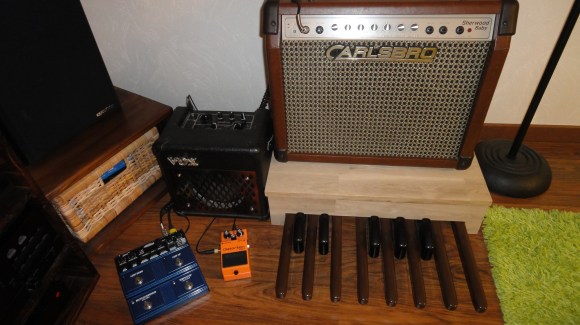
Since his string bass player isn’t always around [Antoine] built his own electric bass stand-in using the pedals from an old organ. The project — which he calls the Organ Donor — was inspired by a similar standalone organ pedal bass project. That instrument was built using a 555 timer to generate the sound. But [Antoine] has a little more room for growth as he’s using an old microcontroller development board to generate sound.
The octaves worth of pedals were pulled from an old broken Yamaha A55 Electone organ. After extracting the assembly from the instrument he built a nice wooden case around it. This doubles as a stand for the amplifier which broadcasts the sound. An old Freescale development board is wired up to twelve of the keys (the top C is unused). It generates a square wave at the appropriate frequency for each key. This signal is fed through a low-pass filter before being routed to the audio jack on the back of the case.
Future improvements include building an amplifier into the pedal assembly. We would also love to see different signal processing to expand the range of sounds the pedals can generate. We’re not sure of the capabilities of that microcontroller, but it would be neat to hear tone generation using stored samples.














Like!
Same here Ren! Simple but nicely done project and nicely upgradable and tweakable! I must admit I thought “ugh another midi moog taurus clone” but was nicely surprised :) Keep on tinkerin’
No sound samples?
I had the chance to see it for real :-) Just Awesome!
Where did they hide the demo?
@vonskippy
You’re right, i did not record a demo. I come back soon with a sound sample….
Antoine
Did the same thing with a Hammond pedal set bought off of ebay, but instead of embedding a sound generator, I added a connector into a Korg Microkey that tapped into the key matrix. This allowed me to connect to a PC and use the PC to generate any midi compatible tones. Had to reconfigure the switch mechanics to change the switches from open active to closed active and also add a second closure for making the pedals velocity sensitive. One thing that I found was that the Korg was sensitive to excess capacitance and that a long cable caused the wrong note to play.
sounds like a great fix!
I would like to build a set of pedals any schematics or diagrams around HelP
Can you believe that no enterprising young capitalist at even just ONE of the big international musical instrument producers has bothered to make a commercial version of your highly sendible and useful invention? At least that’s the only conclusion I can reach after searching for one off and on for the last thirty years or so! It can’t be hard for them to build such a product either, but they are too unimaginative and “vintage- nuts” even to consider doing so. Such units would also be of great use to “buskers” and others who, liike me, often perform solo. But no hoity-toity company will deign to make one!
Reminds me of 7-string Stratocasters, or even just “Strat-style” guitars. There are a few very cheap such units from China on ebay, but not one of the “reputable” companies market one. It’s as if no 7-string guitarist could possibly want the two ‘quack” settings [i.e. settings 2 and 4] of a Strat, that we all believe that being able to “blend” just two Pickups together will provide all the tonal variety we 7-stringers could ever need or deserve. [There is a definite BIAS against 7-string players I have noticed from my twenty years playing only such guitars!]
P.S.: Should you ever wish to sell your current unit, or build another one for me, please let me know! I could really put it to good use. You might even consider making a batch of ten or so of them and selling them out of your home until they begin to catch on, which I’m fairly certqain they would. Then yoou could either expand production or simply sell the whole company for a bajillion dollars!
Best regards to you and everyone else reading from Pittsburgh, PA.
BF